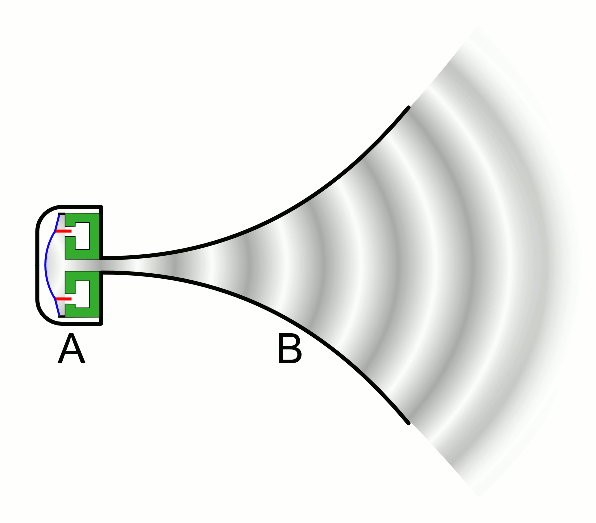Difference between revisions of "Medium"
| Line 5: | Line 5: | ||
: Singular [[Noun]]: '''Medium''' | : Singular [[Noun]]: '''Medium''' | ||
: Plural [[Noun]]: '''Mediums''' | : Plural [[Noun]]: '''Mediums''' | ||
| − | ===About | + | ===About a Medium=== |
: The [[air]] is a '''medium''' that [[sound]] can travel through. If there were no [[air]], [[sound]] could not travel from one place to another and we would not hear anything. | : The [[air]] is a '''medium''' that [[sound]] can travel through. If there were no [[air]], [[sound]] could not travel from one place to another and we would not hear anything. | ||
| Line 14: | Line 14: | ||
| style="height:20px; width:200px; text-align:center;" |A [[vibration]] causing [[sound]] to travel through a medium. | | style="height:20px; width:200px; text-align:center;" |A [[vibration]] causing [[sound]] to travel through a medium. | ||
|} | |} | ||
| + | |||
| + | ==Key Stage 3== | ||
| + | ===Meaning=== | ||
| + | A '''medium''' is any [[material]] that [[sound]] or [[light]] travels through. | ||
| + | |||
| + | ===About Media=== | ||
| + | [[Sound]] can travel through the following '''media''': | ||
| + | *[[Solid]]s - [[Sound]] can passes most quickly through [[solid]] [[material]]s. | ||
| + | *[[Liquid]]s - [[Sound]] can pass through any [[liquid]]. | ||
| + | *[[Gas]]es - [[Sound]] can passes most slowly through [[gas]]es, including [[air]]. | ||
| + | : [[Sound]] cannot pass through a [[vacuum]]. | ||
| + | [[Light]] can travel through the following '''media''': | ||
| + | *[[Transparent]] [[Solid]]s, [[Liquid]]s and [[Gas]]es - [[Light]] can pass through without being [[Absorb (Physics)|absorbed]]. | ||
| + | *[[Translucent]] [[Solid]]s, [[Liquid]]s and [[Gas]]es - [[Light]] passes through [[translucent]] [[solid]]s but some of the [[light]] is [[Absorb (Physics)|absorbed]]. | ||
| + | *[[Vacuum]] - [[Light]] can pass through a [[vacuum]]. | ||
| + | |||
| + | ==Key Stage 4== | ||
| + | ===Meaning=== | ||
| + | A '''medium''' is any [[material]] through which a [[wave]] travels. | ||
| + | |||
| + | ===About Media=== | ||
| + | [[Sound]] can be [[transmitted]] through the following '''media''': | ||
| + | *[[Solid]]s - [[Sound]] is [[transmitted]] most quickly through [[solid]] [[material]]s. | ||
| + | *[[Liquid]]s - [[Sound]] is [[transmitted]] through any [[liquid]]. | ||
| + | *[[Gas]]es - [[Sound]] is [[transmitted]] most slowly through [[gas]]es, including [[air]]. | ||
| + | : [[Sound]] cannot pass through a [[vacuum]]. | ||
| + | [[Light]] can be [[transmitted]] through the following '''media''': | ||
| + | *[[Transparent]] [[Solid]]s, [[Liquid]]s and [[Gas]]es - [[Light]] is [[transmitted]] without being [[Absorb (Physics)|absorbed]]. | ||
| + | *[[Translucent]] [[Solid]]s, [[Liquid]]s and [[Gas]]es - [[Light]] is [[transmitted]] through [[translucent]] [[solid]]s but some of the [[light]] is [[Absorb (Physics)|absorbed]]. | ||
| + | *[[Vacuum]] - [[Light]] is [[transmitted]] through a [[vacuum]] at 300,000,000m/s. | ||
| + | : [[Light]] can also be [[scatter]]ed when being [[transmitted]] through a [[medium]] which is when the [[light]] collides with a [[particle]] in that [[medium]] and changes direction. The [[sky]] is blue because the [[Nitrogen]] in the [[Earth's Atmosphere|atmosphere]] [[scatter]]s blue [[light]]. | ||
Revision as of 08:34, 19 February 2019
Contents
Key Stage 2
Meaning
A medium is any material that sound or light travels through.
About a Medium
- The air is a medium that sound can travel through. If there were no air, sound could not travel from one place to another and we would not hear anything.
| A vibration causing sound to travel through a medium. |
Key Stage 3
Meaning
A medium is any material that sound or light travels through.
About Media
Sound can travel through the following media:
- Solids - Sound can passes most quickly through solid materials.
- Liquids - Sound can pass through any liquid.
- Gases - Sound can passes most slowly through gases, including air.
Light can travel through the following media:
- Transparent Solids, Liquids and Gases - Light can pass through without being absorbed.
- Translucent Solids, Liquids and Gases - Light passes through translucent solids but some of the light is absorbed.
- Vacuum - Light can pass through a vacuum.
Key Stage 4
Meaning
A medium is any material through which a wave travels.
About Media
Sound can be transmitted through the following media:
- Solids - Sound is transmitted most quickly through solid materials.
- Liquids - Sound is transmitted through any liquid.
- Gases - Sound is transmitted most slowly through gases, including air.
Light can be transmitted through the following media:
- Transparent Solids, Liquids and Gases - Light is transmitted without being absorbed.
- Translucent Solids, Liquids and Gases - Light is transmitted through translucent solids but some of the light is absorbed.
- Vacuum - Light is transmitted through a vacuum at 300,000,000m/s.
